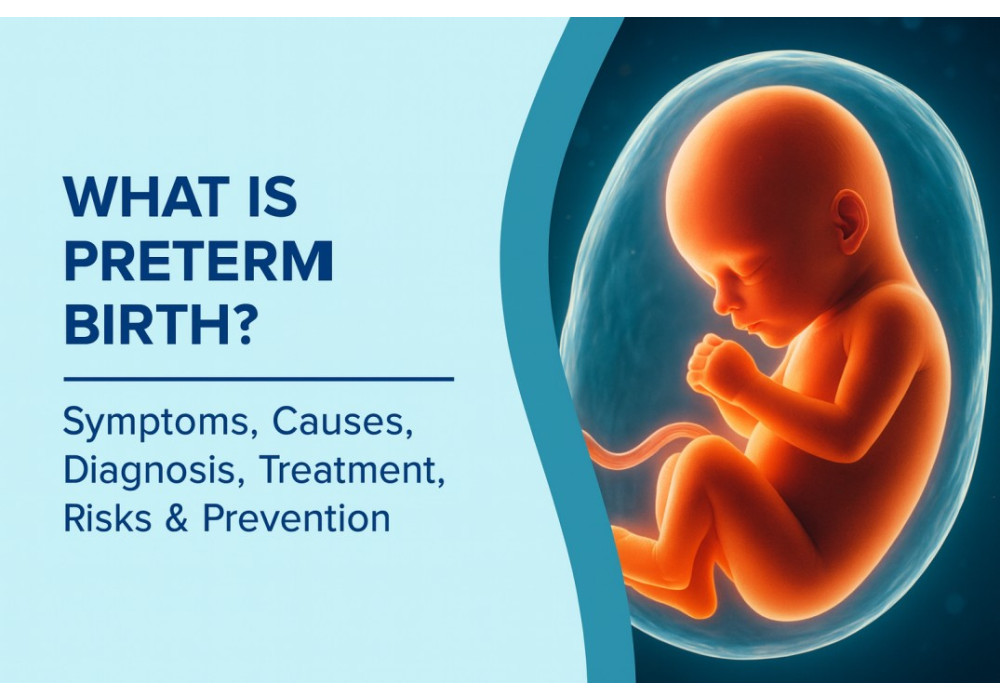
Preterm Birth (Premature Birth): Symptoms, Causes, Diagnosis, Treatment, Risks & Prevention
Category: Pregnancy & Maternal HealthPreterm Birth (Premature Birth): Symptoms, Causes, Diagnosis, Treatment, Risks & Prevention
Preterm birth — also known as premature birth — occurs when a baby is born before 37 weeks of pregnancy. It is a major global health concern that affects millions of babies each year. While many preterm babies grow up healthy, early detection, proper care, and timely medical attention play a crucial role in reducing complications.
This complete guide covers everything you need to know: symptoms, causes, diagnosis, treatment options, potential risks, and ways to prevent preterm birth.
⭐ What Is Preterm Birth?
A pregnancy typically lasts around 40 weeks.
When labor begins too early — before 37 weeks — it is known as preterm labor, and if delivery occurs, it is called preterm birth.
Categories of Preterm Birth
Late Preterm: 34–36 weeks
Moderate Preterm: 32–34 weeks
Very Preterm: 28–32 weeks
Extremely Preterm: Below 28 weeks
The earlier the birth, the greater the risk of complications.
⭐ Symptoms of Preterm Labor
Preterm labor may begin subtly, so understanding the early signs is essential. Seek medical attention immediately if you notice any of the following before 37 weeks:
1. Regular or Frequent Contractions
Contractions every 10 minutes or less
Belly tightening or cramping that doesn’t stop
Increasing intensity and frequency
2. Persistent Lower Back Pain
Dull, achy, or rhythmic pain
Not relieved by rest or changing position
3. Pelvic Pressure or Heaviness
Feeling like the baby is pushing down
Pressure increases when standing or walking
4. Menstrual-Like Cramps
Continuous or wave-like cramps
Often associated with back pain or pelvic pressure
5. Vaginal Discharge Changes
Watery fluid → possible amniotic fluid leak
Mucus plug loss or bloody discharge
Noticeable increase in discharge
6. Fluid Leakage (Water Breaking)
Sudden gush
Continuous trickle of fluid
7. Decreased Baby Movements
If the baby moves less than usual, seek urgent care.
8. Gastrointestinal Symptoms
Diarrhea
Nausea
Stomach cramps
These may precede preterm contractions.
⭐ Causes of Preterm Birth
Preterm birth often results from multiple factors. In nearly half of the cases, no exact cause is found. However, several risk factors increase the likelihood of early labor.
1. Maternal Medical Conditions
High blood pressure / Preeclampsia
Diabetes
Severe anemia
Thyroid problems
Kidney or heart disease
Infections (UTI, vaginal infections, STIs)
2. Pregnancy-Related Complications
Placenta previa
Placental abruption
Excess amniotic fluid
Multiple pregnancy (twins, triplets)
Premature rupture of membranes (PROM)
Short cervical length
3. Lifestyle Factors
Smoking
Alcohol or drug use
Poor diet and malnutrition
High stress levels
Strenuous physical work or long standing
4. Uterine or Cervical Problems
Cervical incompetence
Fibroids
Abnormal uterine shape (bicornuate, septate uterus)
5. Past History
Previous preterm birth
Previous cervical or uterine surgery
6. Socioeconomic & Environmental Factors
Poor prenatal care
Domestic or emotional stress
Exposure to pollution
Long working hours
⭐ Diagnosis of Preterm Labor
If preterm labor is suspected, doctors may use the following tests:
1. Pelvic Examination
Checks for:
Cervical opening
Cervical thinning
Fetal position
2. Ultrasound
Measures cervical length and monitors the baby’s growth.
3. Fetal Monitoring
Tracks:
Uterine contractions
Baby’s heart rate
4. Fetal Fibronectin Test
A vaginal swab test that predicts the risk of early labor.
5. Laboratory Tests
Urine test for infection
Vaginal swabs
Blood tests
⭐ Treatment of Preterm Labor
The goal is to delay delivery, ensure fetal development, and reduce complications.
1. Tocolytic Medications
Help slow or stop contractions for 24–48 hours, allowing time for other treatments.
2. Corticosteroids
Given between 24–34 weeks to help mature the baby’s lungs and reduce risks such as:
Respiratory distress
Brain complications
3. Magnesium Sulfate
Used before 32 weeks to protect the baby’s brain and reduce the risk of cerebral palsy.
4. Antibiotics
If infections such as UTI, PROM, or GBS (Group B Streptococcus) are suspected.
5. Cervical Cerclage
A stitch is placed in the cervix to prevent early opening, especially in women with cervical incompetence.
6. Bed Rest & Hydration
May help calm uterine activity in mild cases.
7. Immediate Delivery (if required)
Doctors may choose early delivery if:
The mother is bleeding heavily
There is a placental abruption
The baby shows distress
The mother has severe preeclampsia
⭐ Risks & Complications Associated With Preterm Birth
Babies born early may face short-term and long-term challenges.
Short-Term Risks
Breathing difficulties (RDS)
Feeding challenges
Low body temperature
Low blood sugar
Jaundice
Infections
Brain bleeding (rare but serious)
Long-Term Risks
Developmental delays
Learning difficulties
Visual or hearing issues
Cerebral palsy
Chronic lung conditions
Access to a good Neonatal Intensive Care Unit (NICU) significantly improves outcomes.
⭐ Prevention of Preterm Birth
Although not all preterm births can be prevented, many steps can reduce the risk.
1. Regular Antenatal Care
Identifies issues like infections, high blood pressure, anemia, or short cervix early.
2. Healthy Diet & Hydration
Eat a nutrient-rich diet containing:
Protein
Iron
Folic acid
Omega-3
Drink plenty of water daily.
3. Avoid Harmful Substances
No smoking, alcohol, or drug use.
4. Manage Stress
Practice relaxation techniques such as:
Yoga
Meditation
Deep breathing
5. Treat Medical Conditions
Control:
Diabetes
Thyroid disorders
Hypertension
6. Progesterone Therapy
Recommended for women with:
Short cervix
Previous preterm birth
7. Cervical Length Monitoring
Done during mid-pregnancy ultrasound.
8. Adequate Pregnancy Spacing
Maintain at least an 18–24 months gap between pregnancies.
9. Avoid Overexertion
Limit heavy lifting, long working hours, and prolonged standing.
⭐ When to Seek Immediate Medical Care
Contact your doctor or visit a hospital immediately if you notice:
Contractions before 37 weeks
Vaginal bleeding
Leaking fluid
Severe lower back or abdominal pain
Decreased baby movements
High fever or chills
Early medical intervention can help prevent or delay preterm delivery.
⭐ Final Thoughts
Preterm birth is a serious but manageable condition. With proper prenatal care, timely diagnosis, and immediate treatment, the risks can be significantly reduced. Awareness of early warning signs helps expectant mothers seek help at the right time, ensuring better health outcomes for both mother and baby.
